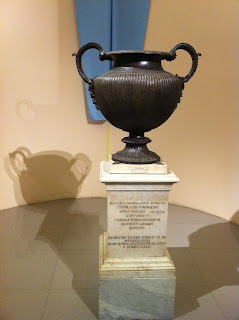Thursday, June 19, 2014 -  Amelia,ARCA 2014,ARCA Intern,Dick Ellis,Orvieto,Tom Flynn
Amelia,ARCA 2014,ARCA Intern,Dick Ellis,Orvieto,Tom Flynn
 No comments
No comments
 Amelia,ARCA 2014,ARCA Intern,Dick Ellis,Orvieto,Tom Flynn
Amelia,ARCA 2014,ARCA Intern,Dick Ellis,Orvieto,Tom Flynn
 No comments
No comments
Report from ARCA Amelia '14: Second week of courses by Flynn and Ellis bookended with visit to Orvieto
 |
| The end of Dr. Flynn's class. Photo by Summer Kelley-Bell |
By Camille Knop, ARCA '14 Intern
Professor Tom Flynn’s course, ‘The International Art Market and Associated Risk’, resumed last Monday with discussions on the tensions between the aesthetic and economic values of works of art. The class concluded two days later with the screening of Furcht, a 1917 German Expressionist film written and directed by Robert Wiene that explores the colonialist roots of collections and the magical haptic quality of works of art that moves one to possess them (even at the risk of one’s safety, in this case). In order to fulfill the course requirements, students composed a 1,500-word response to Gregory Day’s article, “Explaining the Art Market Thefts, Frauds, and Forgeries (And Why the Art Market Does Not Seem to Care).” This exercise allowed students to synthesize and expand on the consequences of the logic of art when put at odds (or not) with the logic of capital.
 | |
| The End of Dick Ellis' class. Photo by Summer Kelley-Bell |
Professor Dick Ellis’ course (“Art Policing, Protection, and Investigating”) the second half of the week included student presentations on art-related crime, focusing on issues regarding due diligence, motivations, and legal and jurisdictional frameworks. Cases ranged from paintings stolen from private property, to an Egyptian pectoral stolen from a university library, to manuscripts smuggled out of Mali, to underwater archaeological looting. The weekend began with many students joining Professor Ellis at two local spots in Amelia: Bar Leonardi and Bar Vertigo.
Despite the forecast of heavy rain, students enjoyed various weekend activities without the stress of any coursework. On Saturday morning, a small group of eight went on an optional trip to Orvieto, which rests on a small plateau of volcanic tuff. After arriving at the foot of the city by bus at around 9:00 a.m., they enjoyed a ride up the funicular that took them right to the edge of the city walls. While some students visited a Roman double-helix well, others wandered around the city, which was preparing for an annual festival that afternoon. Eventually, everyone reunited in the Duomo di Orvieto, whose impressive exterior decoration drew them in like flies to bright lights. Luckily, the group left minutes before a large thunderstorm, which had been seen making its way through the valley towards the city.
 |
| Duomo di Orvieto. Photo by Summer Kelley-Bell |
By the end of the second week of the ARCA program, the initial nervous excitement of orientation and move-in had worn off, and students began to feel more comfortable as they established their daily routines. In my case, the owners of Caffe Grande, concerned with my poor Italian, have been helping me expand my vocabulary from simply “Grazie!” and “Ciao!” by teaching me alternative greetings through some very animated gestures and universal sign language. Although I was not yet prepared to help a lady who had asked me for directions that week, I was still ecstatic over the fact that I had even been asked! By the end of the second week of classes, ARCA students, including myself, have begun to feel (and apparently appear) less like newcomers and more like Amerini.
You may read about the first week of the program here.















